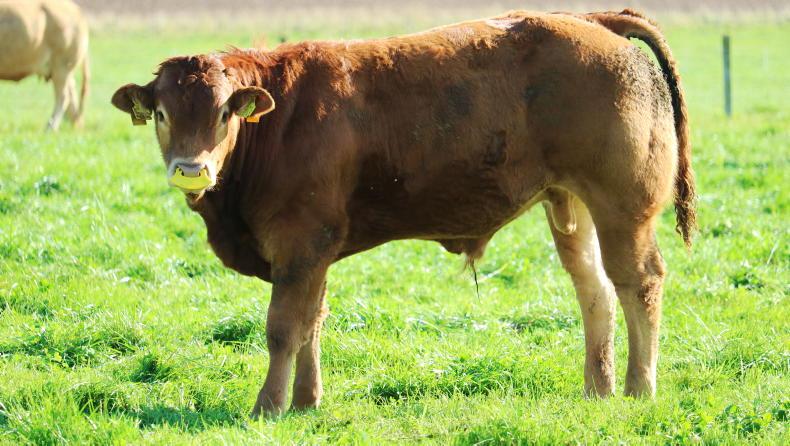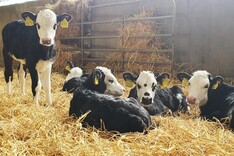Gradually removing cows from the field
The first weaning method works on the principle of weaning calves outside.
Cows are gradually slipped away from calves every couple of days and housed to dry off.
If grass supplies and weather conditions allow, dry cows can be returned to rougher grazing for a few weeks to reduce time spent feeding animals indoors.
The big advantage of this method is weaned calves remain at grass in the same social group, in a familiar environment, so they experience less stress.
As there are cows still running with calves, this also helps to keep animals settled. When selecting which cows to remove from the group, prioritise animals that have the biggest and strongest calves.
Also, prioritise cows that are struggling to hold body condition. Weaning these animals first will help them regain body condition.
The drawbacks to this method is the time needed to gather and split cows every few days. Where cattle are grazing outfarms, there need to be good handling pens to sort animals.
Using nose flaps on calves
The use of lightweight plastic nose flaps inserted into the calf’s muzzle has become popular in recent years.
The nose flap prevents the calf from accessing the teats on the cow’s udder, giving a gradual weaning effect. Calves can still graze and eat concentrate unimpeded.
However, unlike the first option, weaned calves remain with their dam. This keeps calves quiet, reducing stress. As the maternal bond is broken, calves are much easier to transition off the cow.
Nose flaps should be inserted at least one week before the planned weaning date. Once calves are no longer attempting to suck the cow, calves should be split from their dam.
The flaps are easy to insert and reusable. Therefore, the same nose flaps can be reused year after year. However, the downside is that the flaps come with a one-off purchase cost, but this can be diluted by reusing them over a few years.
The other big issue to bear in mind is managing the cow once nose flaps have been inserted. As calves are unable to suck, cows needs to be grazed on low grass covers to prevent mastitis.
This should start before inserting the nose flaps and make sure calves have emptied the udder one last time before starting the weaning process.
Another option is to split cows and calves outside into adjoining paddocks. It is not for everyone and will give fencing a good test. Ideally, start off by allowing calves to creep-graze ahead of cows. Fencing off a headland, or the corner of a paddock, means calves don’t get too far ahead of cows at the start. Offering concentrate will encourage calves to creep forward. Once calves get used to creeping further ahead, the aim should be to pen cows on one side of a stock-proof fence with calves on the other.
If using electric fencing, mains supply is essential. Also, add a second and third strand of wire to hold calves back.
As cows and calves are side by side, they remain relatively settled during the weaning period. Once the bond is fully broken, calves should be moved out of sight of the cows.
As stated, it is not for everyone. But it is effective on the right farm setup. As with option two, cows needs to be kept on low grass covers to prevent the risk of mastitis.
Consider making use of creep areas to take the stress out of weaning. Calves should be weaned over the course of one week. During this period, cows should be fed low-quality silage to reduce milk yield.
For the first two days, only give calves access to cows for 30 minutes morning and night to suck. This keeps the cow’s udder correct.
On days three, four and five, only give calves access to the cows for 30 minutes in the morning. On days six and seven, calves should not get access to the cow but remain in a pen beside them.
On day seven, if a cow looks to be heavy in the udder, the calf can be allowed in to suck for a short period. If there is not enough space in calf creeps to wean all calves the same week, can cows and calves be gradually housed in phases over two to three weeks? Phased weaning means fewer calves will be at risk of respiratory problems, making it easier to manage an outbreak.
Finally, some farmers will choose abrupt weaning, whereby calves are removed from the dam on one day.
While it is much more straightforward from a labour and time perspective, it is much more stressful for calves. Do not try to wean calves on the same day as they are housed.
The change in environment and diet is excessive, making animals extremely vulnerable to pneumonia.
Also, do not try to wean all calves on the same day. Splitting calves in two or three groups is much easier to manage. There will also be fewer animals per group should pneumonia become a problem.
Finally, only use abrupt weaning in bigger, stronger and older calves as these animals are more robust and better able to cope with the stress.
Read more
Department to apologise for ANC cuts
Beef management: getting worming up to date for weaning
Gradually removing cows from the field
The first weaning method works on the principle of weaning calves outside.
Cows are gradually slipped away from calves every couple of days and housed to dry off.
If grass supplies and weather conditions allow, dry cows can be returned to rougher grazing for a few weeks to reduce time spent feeding animals indoors.
The big advantage of this method is weaned calves remain at grass in the same social group, in a familiar environment, so they experience less stress.
As there are cows still running with calves, this also helps to keep animals settled. When selecting which cows to remove from the group, prioritise animals that have the biggest and strongest calves.
Also, prioritise cows that are struggling to hold body condition. Weaning these animals first will help them regain body condition.
The drawbacks to this method is the time needed to gather and split cows every few days. Where cattle are grazing outfarms, there need to be good handling pens to sort animals.
Using nose flaps on calves
The use of lightweight plastic nose flaps inserted into the calf’s muzzle has become popular in recent years.
The nose flap prevents the calf from accessing the teats on the cow’s udder, giving a gradual weaning effect. Calves can still graze and eat concentrate unimpeded.
However, unlike the first option, weaned calves remain with their dam. This keeps calves quiet, reducing stress. As the maternal bond is broken, calves are much easier to transition off the cow.
Nose flaps should be inserted at least one week before the planned weaning date. Once calves are no longer attempting to suck the cow, calves should be split from their dam.
The flaps are easy to insert and reusable. Therefore, the same nose flaps can be reused year after year. However, the downside is that the flaps come with a one-off purchase cost, but this can be diluted by reusing them over a few years.
The other big issue to bear in mind is managing the cow once nose flaps have been inserted. As calves are unable to suck, cows needs to be grazed on low grass covers to prevent mastitis.
This should start before inserting the nose flaps and make sure calves have emptied the udder one last time before starting the weaning process.
Another option is to split cows and calves outside into adjoining paddocks. It is not for everyone and will give fencing a good test. Ideally, start off by allowing calves to creep-graze ahead of cows. Fencing off a headland, or the corner of a paddock, means calves don’t get too far ahead of cows at the start. Offering concentrate will encourage calves to creep forward. Once calves get used to creeping further ahead, the aim should be to pen cows on one side of a stock-proof fence with calves on the other.
If using electric fencing, mains supply is essential. Also, add a second and third strand of wire to hold calves back.
As cows and calves are side by side, they remain relatively settled during the weaning period. Once the bond is fully broken, calves should be moved out of sight of the cows.
As stated, it is not for everyone. But it is effective on the right farm setup. As with option two, cows needs to be kept on low grass covers to prevent the risk of mastitis.
Consider making use of creep areas to take the stress out of weaning. Calves should be weaned over the course of one week. During this period, cows should be fed low-quality silage to reduce milk yield.
For the first two days, only give calves access to cows for 30 minutes morning and night to suck. This keeps the cow’s udder correct.
On days three, four and five, only give calves access to the cows for 30 minutes in the morning. On days six and seven, calves should not get access to the cow but remain in a pen beside them.
On day seven, if a cow looks to be heavy in the udder, the calf can be allowed in to suck for a short period. If there is not enough space in calf creeps to wean all calves the same week, can cows and calves be gradually housed in phases over two to three weeks? Phased weaning means fewer calves will be at risk of respiratory problems, making it easier to manage an outbreak.
Finally, some farmers will choose abrupt weaning, whereby calves are removed from the dam on one day.
While it is much more straightforward from a labour and time perspective, it is much more stressful for calves. Do not try to wean calves on the same day as they are housed.
The change in environment and diet is excessive, making animals extremely vulnerable to pneumonia.
Also, do not try to wean all calves on the same day. Splitting calves in two or three groups is much easier to manage. There will also be fewer animals per group should pneumonia become a problem.
Finally, only use abrupt weaning in bigger, stronger and older calves as these animals are more robust and better able to cope with the stress.
Read more
Department to apologise for ANC cuts
Beef management: getting worming up to date for weaning






 This is a subscriber-only article
This is a subscriber-only article










SHARING OPTIONS: